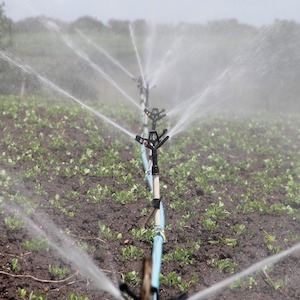Occurrence and distribution of Salmonella serovars associated with human infection isolated from irrigation waters and food-producing animals in southern Italy: eleven-year monitoring (2011-2021)

Accepted: 3 August 2023
HTML: 25
All claims expressed in this article are solely those of the authors and do not necessarily represent those of their affiliated organizations, or those of the publisher, the editors and the reviewers. Any product that may be evaluated in this article or claim that may be made by its manufacturer is not guaranteed or endorsed by the publisher.
Authors
Salmonella is one of the main zoonotic agents causing foodborne diseases in Europe. The main reservoirs of the infection are represented by domestic and wild animals, and the infection occurs by direct contact or following the consumption of contaminated food or water. The study aimed to evaluate the presence of Salmonella spp. in food-producing animals and irrigation waters in southern Italy and the serovar distribution. From 2011 to 2021, a total of 473 samples from 6 different animal species (bovine, buffalo, goat, ovine, swine, poultry, and wild boars) and 313 irrigation water samples were collected and analyzed. The overall percentage of positive samples was 56.87% in organs, 50.85% in feces, and 20.45% in irrigation waters. By animal species, the most frequently detected serovar was Salmonella Typhimurium in bovine (17.39%), in buffalo (13.10%) and swine (28.21%), and S. Kentucky (24.78%) in poultry. The subspecies diarizonaeIIIb was frequently detected in goats (40.00%) and ovine (83.33%), while salamaeII (14.12%) and diarizonaeIIIb (11.76%) were frequently isolated in wild boars. In the irrigation water samples, the most frequently detected serovar was S. Napoli (25%). Results revealed that, although in Europe, control strategies aimed at preventing the spread of Salmonella have been implemented, the prevalence of this pathogen in food-producing animals and irrigation waters is high. Considering the risk to public health associated with the contamination of products or foods, more stringent control interventions are needed at primary production and along the food chain.
How to Cite

This work is licensed under a Creative Commons Attribution-NonCommercial 4.0 International License.
PAGEPress has chosen to apply the Creative Commons Attribution NonCommercial 4.0 International License (CC BY-NC 4.0) to all manuscripts to be published.
Similar Articles
- Dhary Alewy Almashhadany, Sarhang Hayyas Mohammed, Shaymaa Farooq Mala, Mohammed Naji Ahmed Odhah, Asaad Abdel Jalil Ahmood, Frequency, serotyping, antibiogram, and seasonality of Salmonella isolated from red meat markets , Italian Journal of Food Safety: Vol. 13 No. 3 (2024)
You may also start an advanced similarity search for this article.

 https://doi.org/10.4081/ijfs.2023.11538
https://doi.org/10.4081/ijfs.2023.11538



